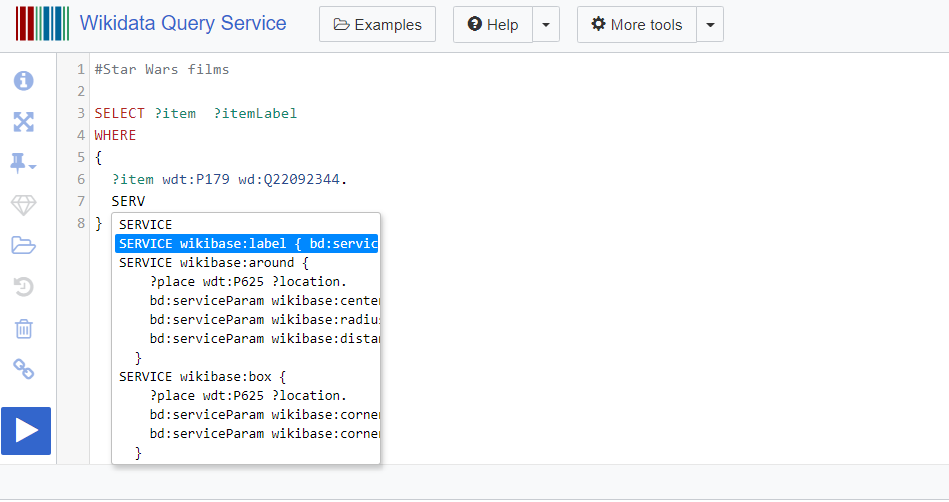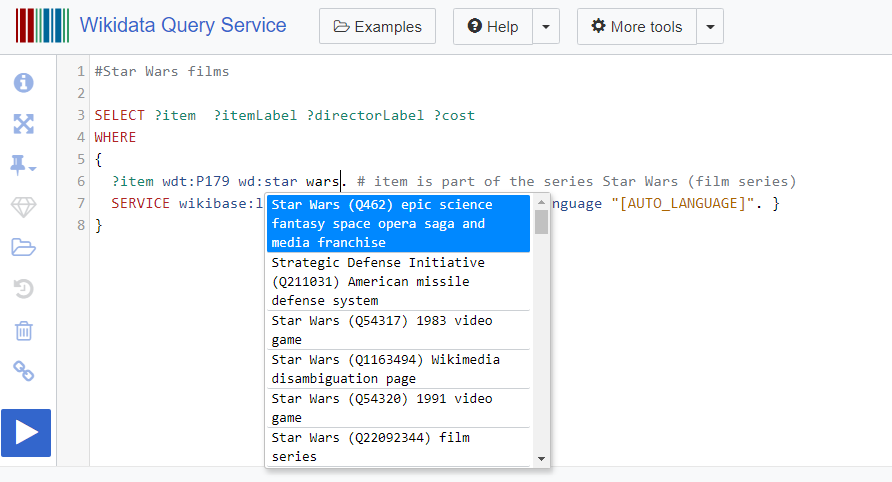Films in the Star Wars Series
Here is your first SPARQL query. This simple query displays the films that are part of the Star Wars series.
#Star Wars Films
SELECT ?item
WHERE
{
?item wdt:P179 wd:Q22092344.
}WDQS color coding
WDQS color codes certain SPARQL words, which helps to understand and to explain the SPARQL code:
- Grey: the first line of the query has a hashtag (#) followed by a grey text. This indicates a comment – something we write that does not affect the query itself. Everything after a ‘#’ is a comment and ignored by WDQS, except certain patterns, which we will see in other sections.
- Red: the words SELECT and WHERE on lines 2 and 3 are shown in capital red letters. This is reserved for SPARQL syntax words, a kind of “command”:
- SELECT – here we state the names of the variables that will be returned and displayed by the query.
- WHERE – here we provide the pattern to match with the data, i.e., define the conditions for finding the values for the variables in the SELECT clause, often in the forms of triples that reflect the Item-Property-Value structure of the database.
- Green: on lines 2 and 5, “?item” appears in green. In SPARQL, variable names are preceded by a question mark and indicated in green. Almost any string can be a variable name (except reserved words), such as ?film, ?x, or ?any_variable_name. Variables hold values for future use.
- Blue: on line 5, we see some terms shown in blue. These indicate prefixes. Prefixes are shortcut abbreviations, allowing queries to be presented in a more compact and transparent manner. Without the prefixes we would need to specify the full URL for each element of the query.
- wdt: a prefix for Wikidata properties + the property (P) number.
Without the prefix we would need to refer to this property as: http://www.wikidata.org/prop/direct/>:P179
- wd: a prefix for Wikidata items + the Q-ID of the value.
Without the prefix we would need to precede the Q-ID by <http://www.wikidata.org/entity/>:Q22092344
- wdt: a prefix for Wikidata properties + the property (P) number.
Query explanation
Now we turn to look at how the query works.
A SPARQL query is usually composed of two or more clauses, which are parts of the query which have different functions. Our basic SPARQL query has two clauses:
The SELECT clause
The SELECT clause lists variables that you want returned – in this case the variable ?item. Essentially this line says “We’re going to find some values to store in ?item, and then we’re going to display those values.”
The WHERE clause
The WHERE clause specifies the conditions for the variables, mostly in the form of triples. SPARQL works on the logic of pattern matching. The SPARQL processor matches patterns you declare within the WHERE clause against the three-part statements stored on Wikidata. The WHERE clause tells the processor which property values to fill into the variables you are SELECTing and how to pull the data out.
This basic query pattern of SPARQL reflects the Item-Property-Value structure of the linked data database. The pattern for matching in our simple query is given as a statement:
?item – has property:part of a series – with value:Star Wars (film series)
In other words, this query selects Wikidata items that: (1) have a property:part of a series (P179), and (2) that property has as value “Star Wars (film series)” (Q22092344).
Note that if you hover with your cursor over the prefix or its associated element, the WDQS interface will show the label and description of that property or item.
Press the “Play” button to run the query. Scroll within the frame to see the results.
The query retrieves the Q number of each of the films in the Star Wars series, but not the title of the film.
In the next part you will learn how to retrieve the names of the films as well.



